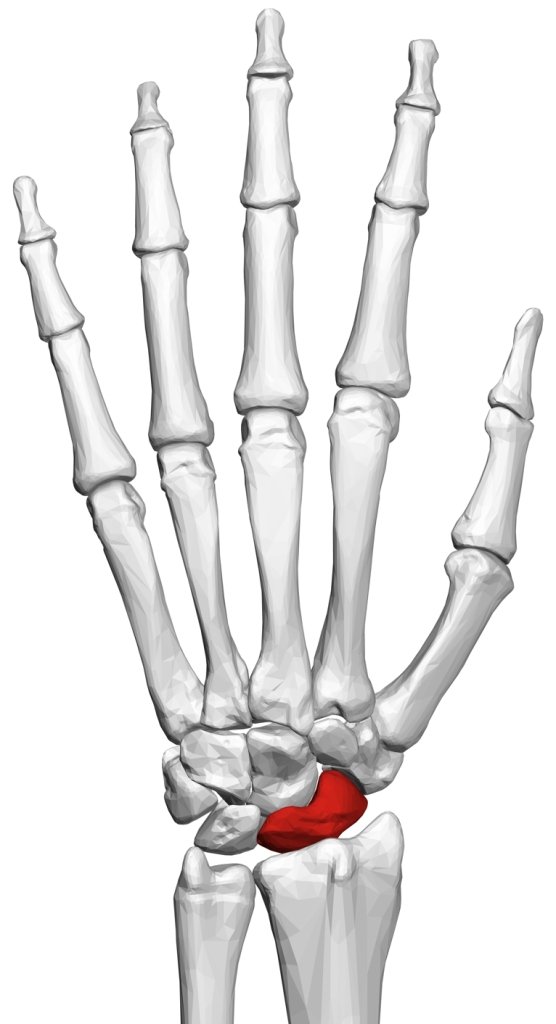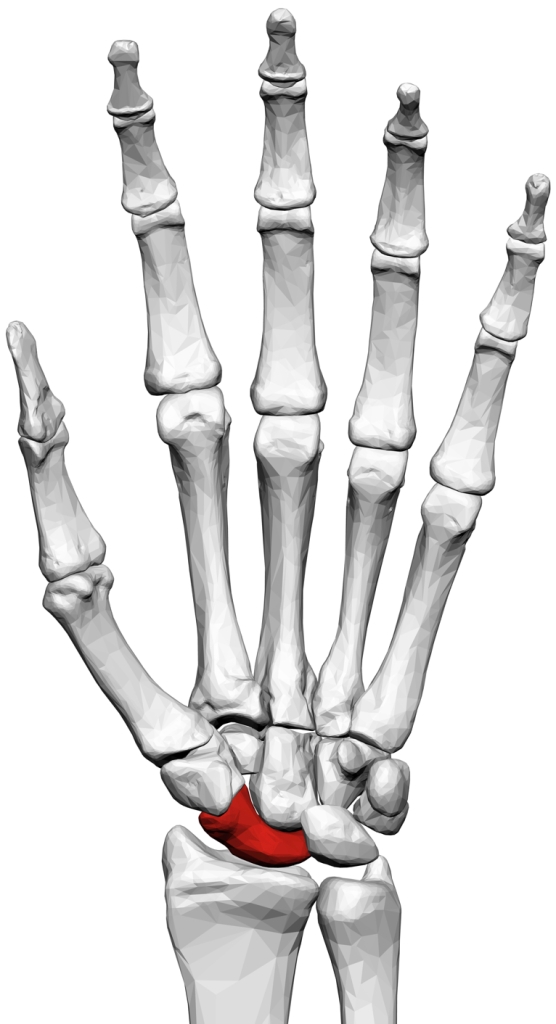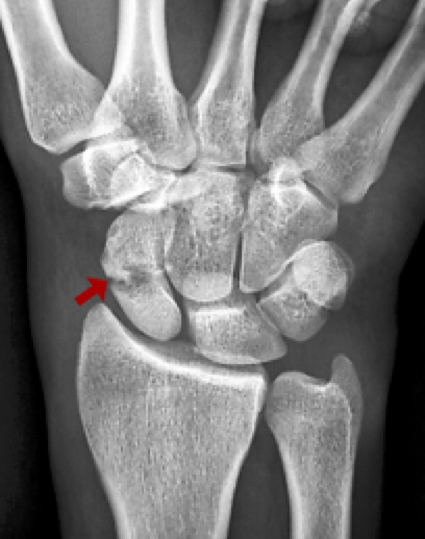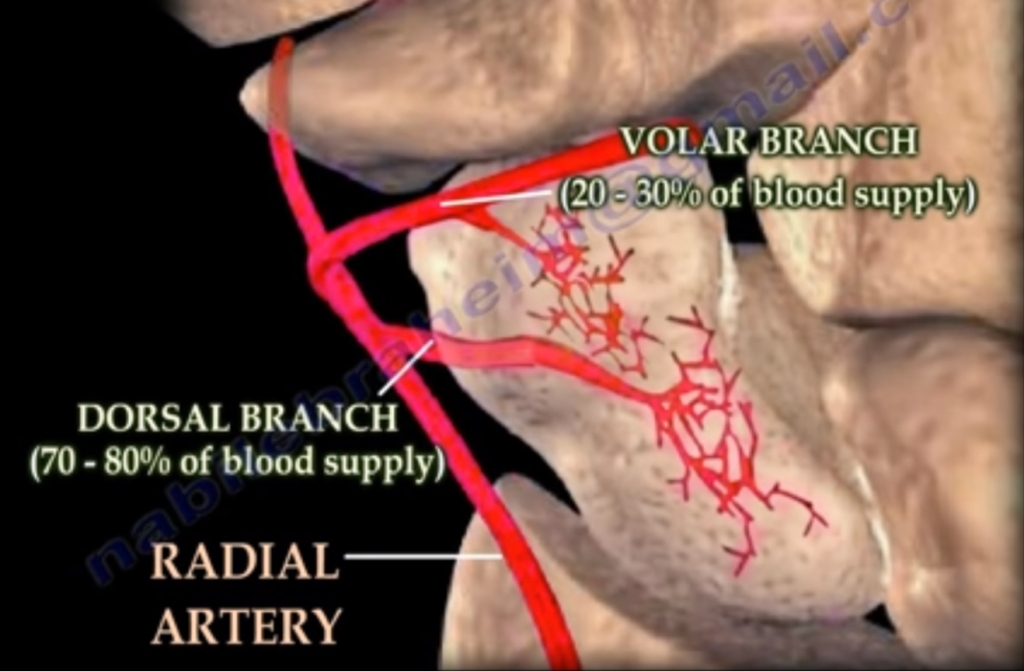What is the scaphoid bone?
The wrist joint is made up of 8 small bones, arranged in 2 rows. The first of these 2 rows, known as the proximal row, is made up of the scaphoid, the lunate and the triquetrum bones. These bones work together to allow smooth movement of the wrist. The scaphoid bone is important in this row because it helps to strut the wrist and maintain normal mechanics. It is approximately the size and shape of a large cashew nut.


How is it injured?
The scaphoid is usually injured by a fall onto the outstretched hand, often from a height or from a bicycle. It can also be injured with the wrist being forcibly bent back e.g. when a goal-keeper makes an awkward save.

What happens when it breaks?
When the scaphoid bone breaks, it can be in one of two ways:
1) Stable injury. Everything is still in the right place in a stable scaphoid fracture, and the bone simply has a crack going through it which can be difficult to see on Xray. The bone still moves as one unit.
2) Unstable injury. The broken parts of the bone do not move together – a gap between the bone ends which do not line up perfectly is often seen on X-ray.
What symptoms will I have?
When the scaphoid bone breaks, there is usually pain over the thumb side of the wrist, but often the whole wrist will be involved and may swell up. The hand can be quite sore with use. The wrist pain and swelling usually settle within the first 6-12 weeks.
OUTCOME – What is likely to happen?
The majority ( around 85% – 90%) of scaphoid fractures heal when immobilised in a plaster cast. This process can take anything from a few weeks up to around 4 or 5 months. Once healed, many scaphoid fractures continue to give nuisance symptoms i.e. the wrist may still be a bit stiff and sore for anything up to to a year.
Around 10%-15% do not heal i.e. become non-unions.
There are several factors which influence the speed of the bone healing:
1) Fracture displacement – in an unstable injury the normal lubricating wrist joint fluid can circulate between the gap between the bone ends. A cyst may form at the fracture site as the joint fluid can promote breakdown of bone – the fracture is then unlikely to heal and surgery is often recommended.
2) Blood supply to the bone. Blood, which is essential for healing, is supplied from the far end of the scaphoid, and runs back down the bone towards the wrist. The near end of the scaphoid therefore has a poor blood supply and a fracture can easily cut it off preventing healing.

3) Smoking. There is a strong association between smoking and non-union (failure of healing) of the scaphoid. You should try to stop smoking if you have a scaphoid fracture, in order to allow the best possible chance of healing.
What are the treatment options?
There are 2 options for treating these fractures.
– Plaster cast / splint. The vast majority of fractures are stable and only require treatment in a cast. If the scaphoid is unstable, it can still be treated in a cast, but the chances of it not healing are higher than if the fracture is stable.
– Surgical Repair (Internal fixation) of the scaphoid. In some circumstances, surgeons may recommend internal fixation of the bone. This is sometimes done through a wound of just a few mm, and sometimes a longer scar over the bone is needed. A wire is passed down the bone across the fracture and a special screw passed over the wire to fix the 2 parts of the bone together. Passing a screw across the fracture turns the injury from an unstable injury into a stable injury, and this gives it a better chance of healing.
Are there any complications of this injury?
Non-union – Unfortunately, the risk of the fracture not healing is around 10-15%. Some non-unions are stable, and although the bone fails to heal, scar tissue still holds the bone ends together, with a good result. However, pain and loss of function are common if the non-union is unstable. Surgery is then usually recommended, although a small number of patients still have long term symptoms following surgery for non-union of the scaphoid.
Read more about Scaphoid Non-Union here
Avascular Necrosis – Avascular necrosis or AVN is the name given when the blood supply to the scaphoid bone fails. The scaphoid usually does not heal, and surgery may be recommended when this happens. AVN has a strong association with smoking.
Arthritis – The term arthritis is used when the normal joint lining (articular cartilage) becomes damaged or worn.
Articular cartilage is the smooth, white tissue lining the ends of bones where they form joints, allowing the bones to glide over each other with very little friction.
Very mild arthritis is often seen on X-rays following scaphoid fractures, but symptoms from this are unusual. More severe arthritis can occur when the scaphoid does not heal giving significant pain. This is a difficult problem and the surgeon will then usually discuss fusing the bones in the wrist. This type of surgery is known as ‘reconstructive’ surgery, because it relies on altering the anatomy of the wrist to relieve pain.

© Lothian Virtual Hand Clinic 2023